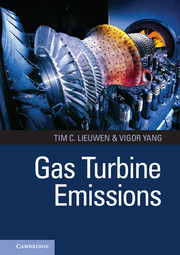Book contents
- Frontmatter
- Contents
- List of Contributors
- Foreword
- Preface
- Part 1 Overview and Key Issues
- 1 Aero Gas Turbine Combustion
- 2 Ground-Based Gas Turbine Combustion
- 3 Overview of Worldwide Aircraft Regulatory Framework
- 4 Overview of Worldwide Ground-Based Regulatory Framework
- Part 2 Fundamentals and Modeling: Production and Control
- Part 3 Case Studies and Specific Technologies: Pollutant Trends and Key Drivers
- Index
- References
2 - Ground-Based Gas Turbine Combustion
Metrics, Constraints, and System Interactions
from Part 1 - Overview and Key Issues
Published online by Cambridge University Press: 05 June 2013
- Frontmatter
- Contents
- List of Contributors
- Foreword
- Preface
- Part 1 Overview and Key Issues
- 1 Aero Gas Turbine Combustion
- 2 Ground-Based Gas Turbine Combustion
- 3 Overview of Worldwide Aircraft Regulatory Framework
- 4 Overview of Worldwide Ground-Based Regulatory Framework
- Part 2 Fundamentals and Modeling: Production and Control
- Part 3 Case Studies and Specific Technologies: Pollutant Trends and Key Drivers
- Index
- References
Summary
Introduction
A serious need for future energy resources worldwide is apparent, driven by high-population countries such as India and China that are rapidly developing infrastructure for energy, as well as growth or repowering in developed countries. Gas turbines play a preeminent role in the stationary power generation marketplace and should remain a critical part of the market mix for the foreseeable future, despite competition from reciprocating engines and newer technologies such as fuel cells. Alternative technologies compete with gas turbines in certain size classes, but at power generation levels above 5 MW, gas turbines offer the most attractive option because of their relatively low capital, operating, and maintenance costs. Hence, these engines are increasingly relied upon for clean power production from a variety of fuels. The configurations for these systems involve high efficiencies as well. As a result, the market will continue to demand gas turbines.
Chapter 1 discusses the drivers and consideration for aero gas turbines. While much of that discussion applies to gas turbines in general, the use of gas turbines for ground-based applications gives rise to additional and/or different metrics, constraints, and much wider possible overall system interactions relative to the combustion system. These turbines vary in size from 10 s of kW to hundreds of MW. The applications vary from power generation to mechanical work (e.g., Soares, 2008). In power generation, the gas turbine shaft is coupled to a generator either directly or via a gearbox (“direct drive”). For mechanical work, the gas turbine provides power to a mechanical device such as a compressor or pump (“mechanical drive”). In power generation, the gas turbine may often be combined with other equipment to form “combined cycle” systems (e.g., combining a gas turbine generator with infrastructure to collect exhaust heat to produce steam to drive a steam turbine).
- Type
- Chapter
- Information
- Gas Turbine Emissions , pp. 24 - 80Publisher: Cambridge University PressPrint publication year: 2013
References
- 4
- Cited by



